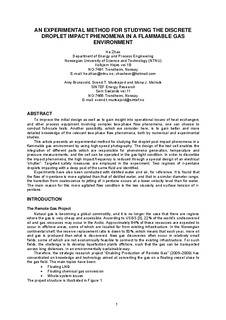| dc.contributor.author | Zhao, He | |
| dc.contributor.author | Brunsvold, Amy | |
| dc.contributor.author | Munkejord, Svend Tollak | |
| dc.contributor.author | Mølnvik, Mona J. | |
| dc.date.accessioned | 2017-03-16T08:33:33Z | |
| dc.date.available | 2017-03-16T08:33:33Z | |
| dc.date.created | 2010-12-06T08:43:15Z | |
| dc.date.issued | 2010 | |
| dc.identifier.citation | Journal of Natural Gas Science and Engineering. 2010, 2 (5), 259-269. | nb_NO |
| dc.identifier.issn | 1875-5100 | |
| dc.identifier.uri | http://hdl.handle.net/11250/2434273 | |
| dc.description.abstract | To improve the initial design as well as to gain insight into operational issues of heat exchangers and other process equipment involving complex two-phase flow phenomena, one can choose to conduct full-scale tests. Another possibility, which we consider here, is to gain better and more detailed knowledge of the relevant two-phase flow phenomena, both by numerical and experimental studies. This article presents an experimental method for studying the droplet-pool impact phenomena in a flammable gas environment by using high-speed photography. The design of the test cell enables the integration of different parts which are responsible for phenomena generation, temperature and pressure measurements, and the cell can be operated in the gas-tight condition. In order to discretize the impact phenomena, the high impact frequency is reduced through a special design of an electrical “shutter”. Targeted safety measures are employed in the experiment. Two regimes of n-pentane droplets impacting with a deep pool of the same fluid are identified. Experiments have also been conducted with distilled water and air, for reference. It is found that the flow of n-pentane is more agitated than that of distilled water, and that in a similar diameter range, the transition from coalescence to jetting of n-pentane occurs at a lower velocity level than for water. The main reason for this more agitated flow condition is the low viscosity and surface tension of n-pentane. | nb_NO |
| dc.language.iso | eng | nb_NO |
| dc.publisher | Elsevier | nb_NO |
| dc.title | An experimental method for studying the discrete droplet impact phenomena in a flammable gas environment | nb_NO |
| dc.type | Journal article | nb_NO |
| dc.type | Peer reviewed | nb_NO |
| dc.source.pagenumber | 259-269 | nb_NO |
| dc.source.volume | 2 | nb_NO |
| dc.source.journal | Journal of Natural Gas Science and Engineering | nb_NO |
| dc.source.issue | 5 | nb_NO |
| dc.identifier.doi | 10.1016/j.jngse.2010.07.002 | |
| dc.identifier.cristin | 511873 | |
| dc.description.localcode | © 2010 Elsevier B.V. All rights reserved.This is the authors' accepted and refereed manuscript to the article. | nb_NO |
| cristin.unitcode | 194,64,25,0 | |
| cristin.unitname | Institutt for energi- og prosessteknikk | |
| cristin.ispublished | true | |
| cristin.fulltext | postprint | |
| cristin.qualitycode | 1 | |
